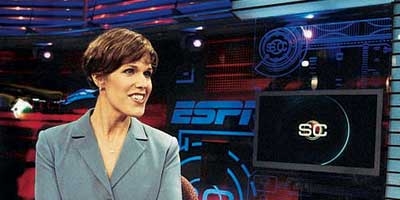HDTV Insider: This Is /Digital/ SportsCenter Page 3
A New EraAnd so it was that on the night of Monday, June 7, ESPN started broadcasting SportsCenter from the Digital Center . The transition wasn't as simple as relocating the show's anchors from one desk to the next and flicking a few switches. The first edition of the show featured a new set and fresh graphics as well as a slightly tweaked version of the familiar da-da-DA-da-da-DA theme music.
Ensconced in his familiar throne on the SportsCenter set, Dan Patrick clearly appreciates the bells and whistles - as witnessed by a middle-of-sentence "Look at that!" when the video tower briefly flares to life - but the bottom line for him remains delivering information cleverly and concisely. "[The technology] visually charges the show for the audience, but it's still an hour of TV. You still have to do your job. As great as it might be, the presentation always comes second."  SportsCenter co-host Dana Jacobson on the show's new set.
SportsCenter co-host Dana Jacobson on the show's new set.
ESPN did experience its share of frustration during its technological growth spurt. In traditional broadcasting, if you buy a tape machine and plug it in, it will likely work as expected. In HDTV, there are lines upon lines of code, which has made debugging tedious and often exasperating for ESPN. "We can't go to somebody else and ask 'What should we do?' because nobody else has done it," Bob Eaton says. As a result, many of the company's queries have been routed straight to the R&D folks who helped give birth to the products in question.
Also, as makeup artists dolling up starlets for this year's Academy Awards learned the hard way, HDTV cameras aren't especially forgiving. Burns recalls sitting in a remote production truck before a Dodgers/Angels ESPN broadcast, entranced by the clarity of a pimple on the neck of a Los Angeles pitcher. But the on-air talent doesn't seem especially worried. "The makeup is different, but you go with it," says Jacobson. Adds Patrick, "Let's face it: we're not good-looking guys. It isn't an issue."
ESPN hopes to be almost entirely tapeless within two years, though execs say that it's not likely the rest of the broadcasting world will make the digital transition as quickly. To avert potential formatting crises, a room on the top floor of the Digital Center has been stocked with machines that can accommodate nearly every extant video format.
Bryan Burns says he is asked "once an hour" about whether the network plans to broadcast exclusively in high-def, but he doubts it will happen anytime soon. "We'll show The World's Strongest Man at 2 p.m. [in standard-definition], and it'll do fine," he explains. "That was produced seven years ago in South Africa . It's not a major priority to get it into HD." By next spring, though, more than half of the network's schedule will be broadcast in high-def.
Not that Patrick would cut much of a figure in high-def as he exits the SportsCenter studio at the end of the day. As he strides briskly toward the elevator bank, he's already shedding his jacket and tie. Seeing me and my photographer standing nearby, he affects a mock-anguished tone: "Go home! Stop stalking me!" He graciously pauses for a click or two, adding, "You're seeing me do what I always do now: strip." And then the elevator arrives and he disappears with a wave and a smirk. At least for the next few hours, the ESPN diner has closed its kitchen. More: 15 Minutes with Dan Patrick ESPN High-Def Touchdown The world leader in sports is aiming to be the leader in HDTV
- Log in or register to post comments






























































